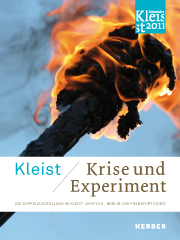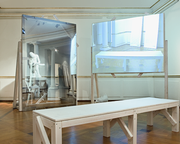The Dramatic Staging of the Exhibition
The exhibition Kleist: Crisis and Experiment adopts two different modes of handling and relating the poet’s life, work and personality in its two separate locations, while simultaneously emphasising the project’s joint umbrella. In principle, the catalogue and project advertising will inform visitors to each of the sections about the other part of the exhibition, presenting it as integral to the overall project.
The dramatic staging mirrors the architecture
In the Ephraim Palais of Berlin’s municipal museum there are three oval halls, one above the other. The respective floors are accessed in both directions from these halls. In the Kleist exhibition they function as key areas providing orientation with regard to the overall content. Here, the catastrophes and traumas in Kleist’s life are presented and individual biographical, work-related and cultural-historical aspects unfold from them.
1st Floor: Kleist’s trauma as a child soldier in the military
2nd Floor: Prussia’s catastrophe – Jena and Auerstedt 1806
3rd Floor: The economy of sacrifice: Kleist’s suicide
These three fields of catastrophe form a stable vertical axis to the exhibition, and the sequence of rooms on the three floors – leading visitors via a horizontal logic – examines the references and consequences of each central area. The 1st floor focuses on the way Kleist escaped from the military and war by employing various strategies to find happiness and himself (study and scholarship, love and friendship, and travel and emigration), while the 2nd floor examines the way in which he came to terms with Prussia’s defeat by Napoleon (patriotic fantasies, catastrophes as a literary theme, the struggle to survive with literature and journalism). On the 3rd floor, the topic under examination is the ambivalence of suicide and self-presentation and the subsequent history of reception under the keyword “Kleist’s return”.
The Frankfurt exhibition
To complement the Berlin section of the exhibition – which is around five times as big as the section in Frankfurt (Oder) –, the exhibition in five rooms of the Kleist Museum lays emphasis on Kleist’s five personalities, allowing visitors to take a detailed look at Kleist as an individual:
Room 1: Body
Room 2: Gender
Room 3: Performance
Room 4: Status
Room 5: Existence
Both sections of the exhibition, in Berlin and Frankfurt (Oder), retain a logical narrative perspective in themselves; the catalogue and any printed materials will always refer to both parts. Basic information on Kleist is provided in both exhibitions, and in such a way that the visitor can develop his own picture, avoiding a dominantly fragmentary impression. In this context, of course, it is impossible to exclude repetition.

The exhibition catalogue
The narrative staging of the exhibitions is underlined by a catalogue concept which follows the aforementioned themes in short survey texts and chapters.



